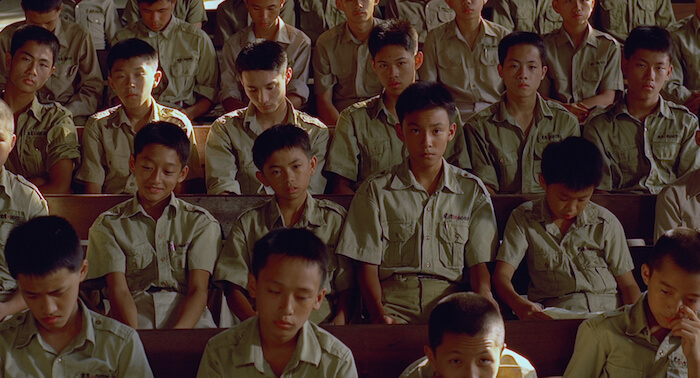Enter the Void: A Brighter Summer Day


Courtesy of Janus Films
A Brighter Summer Day (1991)
Directed by Edward Yang
March 11-14 at BAM
March 22 on DVD and Blu-Ray from the Criterion Collection
After years, decades of wait, it has arrived. Finally, what many critics hail as the masterpiece of 90s Taiwanese cinema is here to stay, thanks to a new restoration from Janus Films. A void has been filled. And it’s with voids, and small illuminations, that Edward Yang tells the expansive coming-of-age story of a young man’s descent into delinquency.
Early in A Brighter Summer Day, we learn that millions of Chinese have fled from the mainland to Taiwan with the Nationalist government after defeat by Chinese Communists in 1949, pushing many children to join street gangs as a means of identity and security. This is a key point, as, for four slow-burning hours (every moment seemingly imperative), an existential identity crisis of a massive emigration emerges.
The story—one we’re seeing in more politicized form today—begins in 1960 Taipei, where two rival gangs, the Little Park Boys and 217, contend for the upper hand. The story centers on fourteen-year-old S’ir (Chang Chen), of the former clan, who seems like a smart kid, but finds himself deeply entangled in the gang rivalry while falling for Ming (Lisa Yang), an anguished classmate and girlfriend of Little Park Boys leader, Honey (Hongming Lin). Meanwhile, S’ir’s father (Chang Kuo-Chu), a civil servant, is casually taken from his home only to be gradually tongue-lashed with vicious interrogation by secret police suspicious of his business affairs, belittling him to nothing. We witness a plethora of interactions, interweaving S’ir’s family relations with his own endeavors of discovery. What emanates from this colossal narrative, like magma slowly spilling down a volcano, is an epic portrait of tried and tired love, paranoia, betrayal, and essentially emptiness, the reflection of a vacuous shell of displacement.
A Brighter Summer Day takes its title from lyrics of Elvis Presley’s “Are You Lonesome Tonight?”, which would itself be a fitting film title. The kids here engage with American rock ‘n’ roll on a regular basis, learning English lyrics and singing in clubs, an attribute Yang pushes to accentuate a disillusioned sense of self. Like the Japanese house S’ir’s family finds themselves living in, or the infatuation with a Samurai sword, we are looking deeply into a cultural void wherein the only pride comes from foreign objects or engagements derived from an unowned ethnology. S’ir’s family’s most prized possessions are a watch that is pawned more than once, and a dilapidated radio that has to be balanced on books and beat around in order to work, objects from another time and place, further reflecting an unnerving instability, a vacant sense of identity. A flashlight is yet another object that takes precedent. Stolen from a filmmaker’s studio at the beginning of the film, it guides S’ir through labyrinths of darkness, including a gruesome encounter that foreshadows his own downfall, only to be left behind in the place it was swiped from, a movie set where, specifically, a black and white film is being made—a film which will hide all colors and all flaws.
Yang is often praised for his storytelling, and A Brighter Summer Day is certainly a massive endeavor, with over 100 mostly nonprofessional actors, but it is with imagery that the sentiments of his messages are repeatedly masticated. Often we are confronted with voids via the director’s favored medium to long shots. In a doctor’s office, as S’ir describes to Ming his recent demerit and confrontation with the 217 boys as an excuse as for why he didn’t attend her screen test for a potential acting gig, the camera shifts towards and focuses intently on a close-up of a painted door, barely reflecting the two figures, and stays there, articulating S’ir’s self-proclaimed “string of bad luck” as two impalpable ghosts. Blackouts are common occurrences, telling not only of the characters’ basic economic needs, but of the voids they endure as a culture. The darkness is relieved only by faint candles or cheap light fixtures, small illuminations, implications that darkness is here to stay. A gang massacre takes place during a monsoon in almost complete visual opacity, save a few flashes of kindling bloodshed. The most memorable shot in A Brighter Summer Day comes when S’ir and two of his cronies are confronted by a group of 217 boys. The rival gang stands in a black void, completely unseen, framed by a brick archway. We hear their echoes and taunts but only a dark vacuum occupies our vision. Suddenly a basketball is launched from the void and into the light. S’ir defiantly picks up the basketball as to confront his adversaries, but it only means a brutal beating, as if to suggest that whatever emerges into the light will quickly burn out.
You might also like 




















